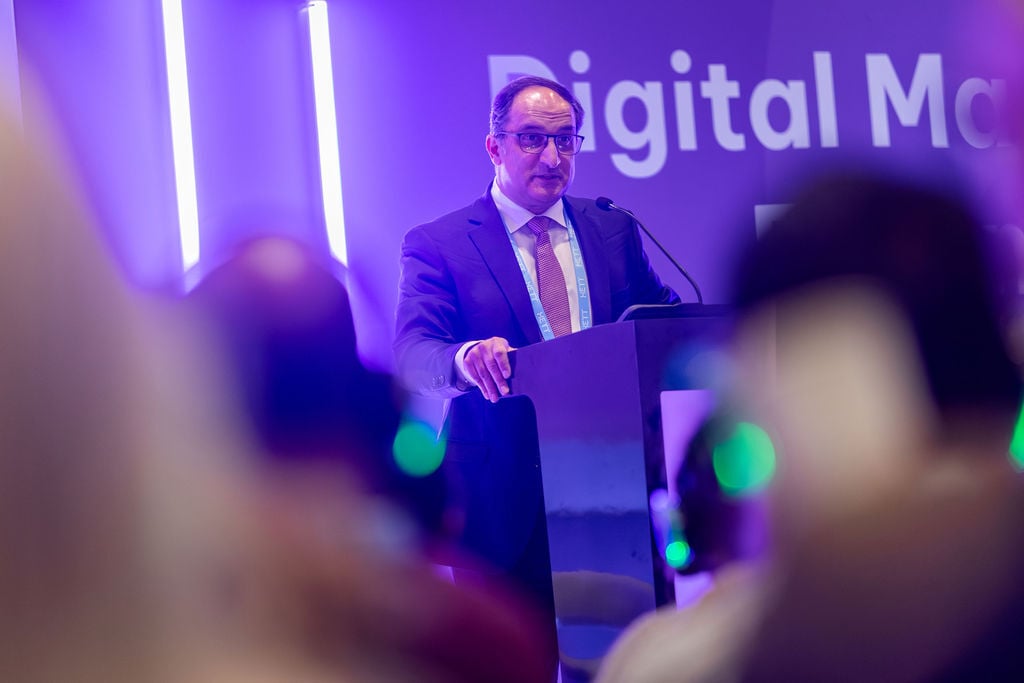HETT 2025 kicked off with a keynote from Alec Price-Forbes, National Chief Clinical Information Officer (CCIO) at NHS England.
His address focused on the activation and delivery of the NHS 10-Year Health Plan. What will bringing care closer to communities look like? How will a prevention-first approach change clinical practice? And what will digital tools mean for patient outcomes and frontline teams?
As the first opportunity for the healthcare community to explore the plan since its publication, the session sparked conversation around these questions and the scale of change required to implement them.
Understanding the Pressures Facing the NHS
Alec began by acknowledging the scale of the challenges confronting the NHS and how we must learn from the past if we are going to plan effectively for the future. He outlined the stark realities: financial pressure, staff well-being, and public dissatisfaction.
“The future of our NHS from a financial perspective is unsustainable.” The UK spends around 11% of its GDP on health, accounting for 38% of all public expenditure. Almost half of that goes to staffing, excluding GPs, and that figure is only expected to rise.
Workforce challenges are also deepening. Staff sickness rates are at an all-time high, and one in ten staff left the service last year. “Leaving aside the well-being of a beleaguered and demoralized workforce,” Alec noted, “the public are fed up with the service we provide.”
In 2024, 59% of people were dissatisfied with the NHS, largely due to delays in accessing care. At the same time, people are living longer but spending more years in ill health. “Healthy life expectancy lags ten years behind average life expectancy,” he explained, with widening inequalities across the country. Those in the most deprived areas wait more than twice as long for elective procedures.
Technology, too, is part of the problem. “Our patients and our staff are being let down by technology that is not fit for purpose.” Data remains fragmented, administrative workloads are excessive, and only 11% of staff feel they have the tools to do their job effectively. Health and care professionals spend more than 14 hours each week generating documentation, and 70% cite poor interoperability as the biggest barrier to community-based care.
“In short,” he concluded, “we’ve spent a lot of money digitising what we did on paper. And the paradox we face is that rather than technology making things easier, it often feels like it’s making things harder.”
Delivering the 10-Year Health Plan
Alec used a clear analogy to describe the current state of NHS technology: “The NHS, in essence, remains an analogue service that was built for the 20th century. To put it another way, it’s Blockbuster in the age of Netflix. And unless it reforms, it will go the same way as Blockbuster.”
While the NHS continues to provide vital care, he said that legacy systems alone are not sufficient. “Reform isn’t just about survival, it’s about relevance. The choice before us today is either to change or lose our health service as we know it.”
The government’s 10-Year Health Plan offers a framework for that change. It sets out three shifts: moving care from hospital to community, from treatment to prevention, and from analogue to digital. These shifts form the foundation of a new care model, supported by a revised operating model, updates to finances, a restructured workforce strategy, and a refreshed approach to innovation and research.
Alec emphasized that while the shifts are interconnected, the move from analogue to digital underpins all of them, with 121 technology deliverables identified as part of this transformation. Key initiatives include a new NHS App, a Single Patient Record (SPR), an expanded digital “Red Book” for children’s health, online appointment bookings, and the use of artificial intelligence (AI) and ambient voice technologies to reduce administrative workloads.
The plan also introduces continuous monitoring to support early intervention and prevent hospital admissions. Upgrading core infrastructure and modernising data platforms are central to ensuring these digital services are effective.
Looking ahead, Alec explained that the NHS expects the primary ways people access and communicate with services to be digitally enabled or fully digital. “Rather than embed digital tools into our traditional services and pathways, we will see a fundamental reimagining of how care is designed, delivered, and experienced,” he said, noting that over £10 billion has been allocated over the next three years to support this transition.
Alec described this as a turning point for the NHS, one that requires embedding a “digital by default” mindset throughout the workforce. He framed it as a collective responsibility: building systems, processes, and environments that support both staff and patients, ensuring that digital tools enhance care rather than complicate it.
Building a Digital-First Health System
Alec stressed that digital transformation is not just about adopting new technologies. “It’s about fundamentally changing how an organisation, how a clinician, how a system operates to leverage those technologies for improved performance and benefit to patients.” Success depends on both patients and staff embracing new tools and using them to their full potential, improving the quality and productivity of services.
Technology alone, Alec noted, cannot deliver better care. “Focusing on holistic, person-centred care, technology developed alone is not enough. The most powerful innovation in healthcare is not artificial intelligence. It’s human intelligence: empathy, compassion, and the courage to embrace change when it means better care for our patients.”
Future success, he explained, hinges on embedding systematic approaches to business change and digital adoption. This includes investing in workforce skills, providing the right tools, and creating standardised processes so that high-quality, safe care is delivered consistently. Implementation cannot be top-down; it requires engagement across all organisations, professions, and levels, creating a sustained cultural shift rather than isolated initiatives.
Alec highlighted a sentence from the 10-Year Health Plan that encapsulates a major shift in thinking. Care should happen locally when possible, digitally by default in a patient’s home, in a neighbourhood health centre when needed, and in a hospital only if absolutely necessary. This approach fundamentally changes the NHS business model, decoupling care from physical locations and traditional hospital-centred workflows.
The first practical step toward this vision was announced with the creation of the NHS Virtual Hospital, effectively a “hospital by default,” designed to improve efficiency, reduce waiting times, expand patient choice, and free up clinician capacity for those who truly need face-to-face care.
Digital tools are central to this transformation. A major NHS England study in partnership with Great Ormond Street examined AI and ambient technology across more than 17,000 patient encounters in hospitals, GP practices, mental health services, and ambulance teams.
Findings included a 23.5% increase in direct clinician–patient interaction, an 8% reduction in overall appointment time, a 13% increase in patients seen in ED, and a 35% reduction in clinician workload related to documentation. Patient and family feedback was largely positive, with improved engagement and satisfaction.
The NHS App has similarly become a key enabler of patient empowerment. From April to June 2024, patients contacted their GP 7.5 million times via the app, up from 5 million the previous year, with monthly logins more than doubling to 51.8 million. Use for prescription ordering rose from 1.8 million to 36.6 million instances per month.
By 2028, the app is expected to serve as a “front door” to the NHS, allowing patients to access advice, navigate services, choose providers, book tests, manage medicines and long-term conditions, and coordinate care for dependents.
The SPR underpins these digital-first services. It enables more coordinated, personalised, and predictive care within the neighbourhood health model, integrating genomic and predictive analytics to support prevention and early intervention. Clinicians, paramedics, and community providers will have secure access to real-time patient information, enabling expanded roles such as pharmacy-led long-term condition management and more proactive care.
Alec emphasised that digital transformation must also address equity. Around 7% of households lack home internet, and 10 million adults lack foundational digital skills. The NHS is committed to designing inclusive solutions, including instant translation, screen readers, AI-enhanced hearing aids, national proxy services, and partnerships with public sector and charity organisations to ensure access for underrepresented and deprived communities.
Making Digital More Human
Alec ended the session by introducing a fourth shift: making digital more human. He stressed the need for a culture that values connection, collaboration, and compassion, ensuring that digital services enhance relationships rather than replace them.
He closed with a call to action: NHS leaders and staff must collectively create the right conditions to implement digital solutions successfully, invest in people and change management, and focus on outcomes-based, values-driven care.
There's still time to join us for more tomorrow! Click below to register.
%20(1).png?width=500&height=58&name=HETT%20insights%20logo%20RGB-04%20(1)%20(1).png)



